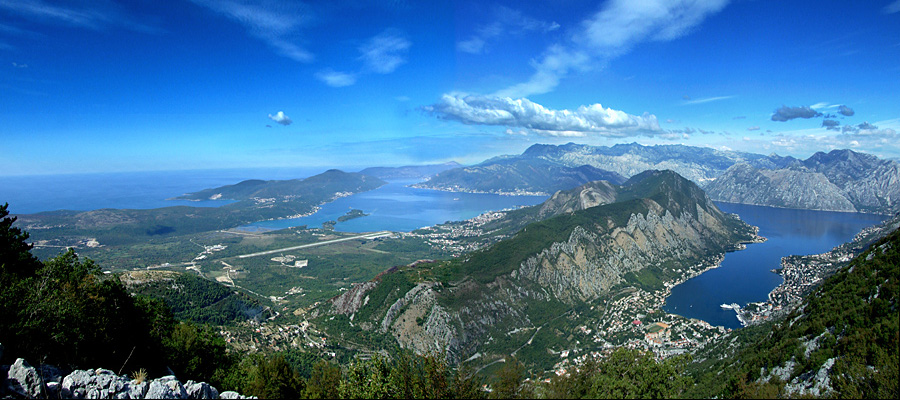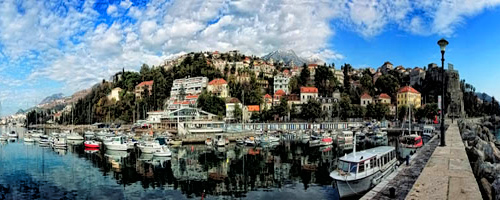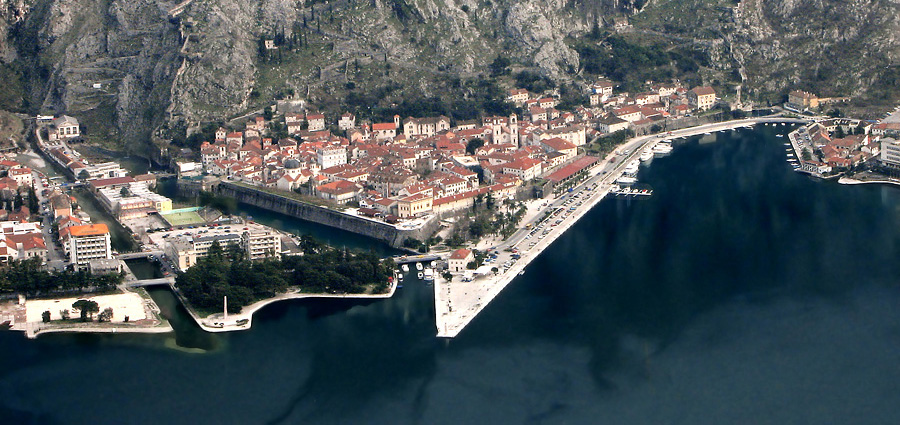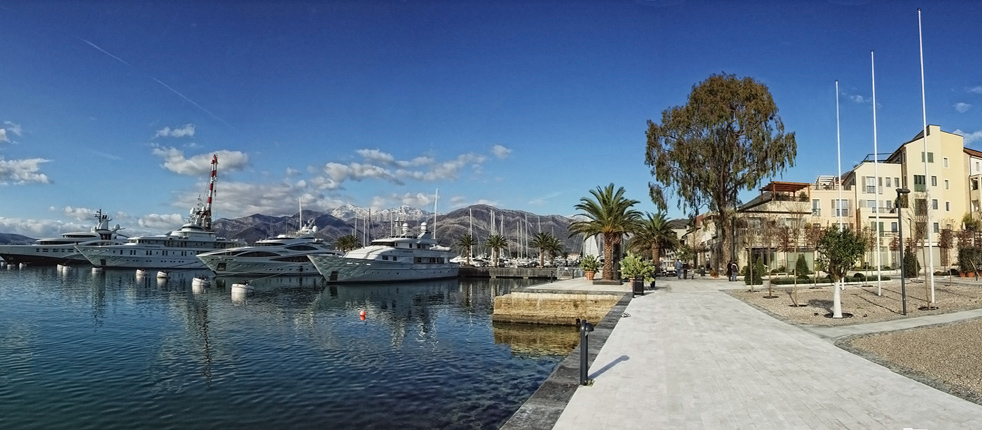Vila Lux TAMARA is located in Herceg Novi, in the Kotor Bay. The precise location can be
found at the Google map on the 'Contact' page.
Coastal towns of Tivat and Kotor are located in proximity, as well as two famous resorts
i mondenska ljetovališta: Perast and Porto Montenegro. In around 40 km from Herceg Novi there are
Budva and Dubrovnik (Croatia).
Below is some brief information about the most important places:

Bride of the Adriatics ...
Anyone who visits the Kotor Bay is experiencing it in its own way, whether it is an artist,
scientist or tourist, and always the Bay strongly affects everyone. The Bay is the place where opposites meet
and unify creating by thus a very special ambience. The contradictions are reflected in nature, where one part
of the quite surface of the sea is rapidly transforming into rocky mountains, while the second part is covered
by real botanical gardens, and the same happens with cultural and historic heritage where two civilizations,
East and West, complementing each other, exist in unique harmony. Prehistoric times, the Illyrian age, antiquity,
Latin-Byzantine era, Gothic, Renaissance, Baroque periods, they all blend into modern life, and it shows and
proves us that real values last forever and coexist together in harmony.
The total water area of the Bay is 87,3 km², water content is 2,4 x 106 km³, max depth – 60m,
average depth – 27,3m, salinity – 28%. The shoreline of the bay is 105,7 km, and it is about 28 km long.
There are seven islets in the Bay, namely: St. Marko, Mamula, Our Lady of the Rock, St. George,
Mercy island, Flower island and Mala Gospa.
Considering that the Kotor Bay is stretched between the Adriatic Sea and coastal karstic part,
the area of the Bay is influenced by Mediterranean and mountain climate that creates a unique type of sub-Mediterranean
climate that differs from other coastal parts of Montenegro. A symbol of the Bay is the early spring when all
the surrounding mountains are covered with snow, whole on the Mediterranean coast you can find blooming plants
and trees. In winter one can enjoy sunny days on the coast, and the mountainous areas can be reached in less than
an hour. The summer in the Bay is usually pleasant though it has a bit more of rainy days than the rest of Montenegrin
coast, which is reflected in luxuriant vegetation. During late autumn and partially winter experience the most of rainy
days, especially in the inner part of the Bay. All along the Bay a rich variety of continental Mediterranean and exotic
plants are spread. These are laurel, olives, palm trees, orange and lemon trees, pomegranates, agaves, oleandrers,
camellias, mimosas, and others.

Town that you will miss ...
Herceg Novi is a coastal town in Montenegro located at the entrance to the Bay of Kotor
and at the foot of Mount Orjen. It is the administrative center of the Herceg Novi Municipality with
around 33000 inhabitants. Herceg Novi was known as Castelnuovo. Herceg Novi has had a turbulent past,
despite being one of the youngest settlements on the Adriatic. A history of varied occupations has
created a blend of diverse and picturesque architectural style in the city.
Herceg Novi is a major Montenegrin tourist destination. It is well known as a spa and
health center; nearby Igalo has an abundance of healing sea mud called "igaljsko blato" (Igalo mud) and
mineral water springs called "igaljske slatine" (Igalo water springs). The most famous tourist attractions
in Herceg Novi are castle Forte Mare built by the Bosnian king Tvrtko I in 1382, a clock tower, the Kanli
tower built by Turks, and the Serbian orthodox church St. Archangel Michael in central square of Belavista.
The coastline of Herceg Novi is known for its promenade that is 7 km long. This fantastic
coastal promenade provides a pleasant walk in any season. Along the promenade, one can find numerous small
beaches. Tourist companies organize one-day boat trips to Luštica peninsula, which lies opposite to the town.
Official web presentation of the Tourist organization of Kotor can be found at
hercegnovi.travel.

UNESCO world heritage site ...
Kotor is an old town located in the Kotor bay. It has around 13000 inhabitants, and municipality
of Kotor around 23000. The old Mediterranean port of Kotor is surrounded by fortifications built during the Venetian
period that are very well preserved and considered as a world heritage site under UNESCO’s protection. Between 1420
and 1797, Kotor has been under the Venetian rule that has given the city the typical Venetian architecture. In recent
years Kotor has seen a steady increase in tourists that are attracted both by the natural beauty of the Gulf of Kotor
and by the old town of Kotor.
Kotor was first settled during Ancient Roman times, when it was known as Acruvium and was part of
the Roman province of Dalmatia. Kotor has been fortified since the early Middle Ages, when Emperor Justinian built
a fortress above Acruvium in 535, after expelling the Ostrogoths. In 1002, the city suffered damage under the occupation
of the First Bulgarian Empire, and in the following year it was ceded to Serbia by the Bulgarian Tsar Samuil. However,
Kotor, taking advantage of its alliance with Dubrovnik, maintained its republican institutions and its right to conclude
treaties and engage in war. During the Nemanjic dynasty-era, the city was autonomous. With the fall of the Serbian Empire,
the city came under the Serbian Despotate. The city acknowledged the suzerainty of the Republic of Venice in 1420. In the
14th century, commerce in Cattaro (as the city was called at that time) competed with that of the nearby Republic of Ragusa
and of the Republic of Venice. The fall of Serbia in 1389 left the town without any protection, and was constantly falling
under the Venetian or Hungarian rule, up until 1420, when it became part of the Venetian Republic. While under Venetian rule,
Kotor was besieged by the Ottoman Empire in 1538 and 1657, endured the plague in 1572, and was nearly destroyed by earthquakes
in 1563 and 1667. After the Treaty of Campo Formino in 1797, it wassed to the Habsburg Monarchy, and in 1805 it was assigned
to the French Empire’s client state, the Napoleonic Kingdom of Italy by the Treaty of Pressburg. In World War I, Kotor was the
site of some of the fiercest battles between Montenegro and Austro-Hungary. After 1918, the city became a part of Yugoslavia
and after 1945 it became a part of the then Socialist Republic of Montenegro within Yugoslavia.
On April 15, 1979, a major earthquake hit the Montenegrin coastal area. Reconstruction lasted for around 10 years, but
it took more time to restore several major buildings, such as St. Tryphon’s Cathedral, St. Luka’s Church, Duke’s palace and others.
Official web presentation of the Tourist organization of Kotor can be found at
kotor.travel.

Tivat is located in the heart of the Kotor Bay, with its beautiful coastline with many beaches,
coves, harbors, and with very attractive hinterland that is not well discovered. The rich archaeological findings
along with cultural and historic heritage testify of its early foundation. Various cultural programs, popular
festivities and sports events have become synonymous of the town. But what is very special about Tivat is its
population with its hospitality and open-mindedness. Anyone who visits Tivat ones always comes back, some of them
because of beautiful well-preserved coastal landscape, the others because they can feel themselves in Tivat as at home.
Official web presentation of the Tourist organization of Tivat can be found at
tivat.travel.
Porto Montenegro is a project of residential complex with a marina that accommodates luxury
yachts. This place has been sought to satisfy all the sophisticated needs of all kind of yachts, their owners, guests
and crew. It has additional infrastructure for mega-yachts. The key investor of the project is Canadian businessman
Peter Munk, founder of the Barrick Gold Corporation. Other famous investors are Lord Jacob Rothschild, Nathaniel
Rothschild, Bernard Arnault, Sandor Demjan and Anthony Munk.
Official web presentation of Porto Montenegro can be found at
portomontenegro.com.
